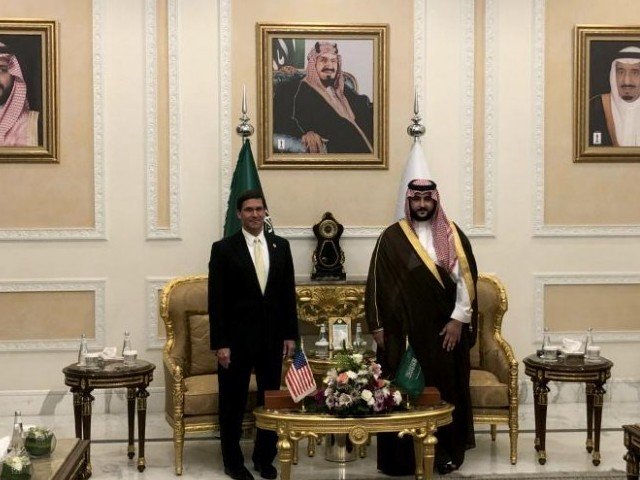Originally posted to the Reuters website, 21 October 2019
RIYADH (Reuters) – U.S. Defense Secretary Mark Esper arrived in Saudi Arabia on Monday, with tensions simmering between Washington and Tehran, and Russia seeking to boost its influence in the Middle East.
Esper is likely to meet King Salman and Crown Prince Mohammed bin Salman on his first trip to the key regional ally since taking office this summer, a visit intended partly to reassure Riyadh over bilateral ties.
Upon landing in Riyadh, he met the head of U.S. Central Command, which is responsible for military operations in the Middle East and Afghanistan.
U.S.-Iran tensions have risen to new highs since May 2018, when the Trump administration withdrew from an international accord that put limits on Tehran’s nuclear program in exchange for easing sanctions.
As reinstated sanctions put pressure on Iran’s economy, there have been a series of attacks which Washington and close allies blame on Tehran. Iran denies responsibility.
The United States has deployed about 3,000 additional military forces since May to bolster Saudi defenses, including an air expeditionary wing and air defense personnel.
Despite the additional troops, President Donald Trump’s sudden withdrawal of forces from northeastern Syria has raised questions about Washington’s commitment to allies and opened the door for Russia to increase its regional influence.
The move was criticized as a betrayal of Kurdish allies who fought for years alongside U.S. troops against Islamic State. Esper said on Monday that at least some troops might stay to deny Islamic State and others access to oil fields.
A senior U.S. defense official said the United States still wants to be seen as the partner of choice in the region and Russia was not as dependable, whether it be the level of training or the military equipment it can provide.
“That being said, the Gulf, they feel vulnerable. They feel exposed, understandably so,” the official said. “They’re having diplomatic relationships with all relevant players in the region and Russia, particularly since its activities in Syria, has shown itself to be a player in the region now.”
President Vladimir Putin signaled Moscow’s growing Middle East clout last week on his first visit to Saudi Arabia in over a decade, buoyed by Russian military gains in Syria, strong ties with regional rivals and energy cooperation.
LONGSTANDING ALLIANCE
Military officials from Arab countries plus the United States, Britain, France, Germany, Italy, Pakistan and South Korea met in Riyadh on Monday to discuss freedom of navigation and Iranian activities in the region.
“I am sensing a tremendous amount of discomfort in the Middle East about what the president’s moves with the Kurds means for the durability of any country’s relationship with the United States,” said Jon Alterman, Middle East expert at the Center for Strategic and International Studies.
The additional deployment comes as many members of Congress have questioned the longstanding U.S.-Saudi security alliance and backed several efforts – which have so far failed – to stop Trump selling arms to Riyadh without congressional approval or providing support to the Saudi-led coalition fighting in Yemen.
Iran has responded apprehensively to previous U.S. troop deployments this year. But Riyadh and Tehran have shown a willingness to talk.
Iran last week urged regional powers to use diplomacy to reduce tensions, including Yemen’s war, but cautioned that an Iranian tanker damaged in the Red Sea had been hit by rockets and there would have to be consequences.
Trump has said Riyadh would pay for the recent U.S. deployments, sparking resentment in some Saudi circles.
“Saudis see the president charging them as a commodification of a relationship of more than seven decades,” Alterman said.
Link to the original post: https://www.reuters.com/article/us-usa-saudi/pentagon-chief-visits-saudi-arabia-as-tensions-simmer-with-iran-idUSKBN1X01O7


